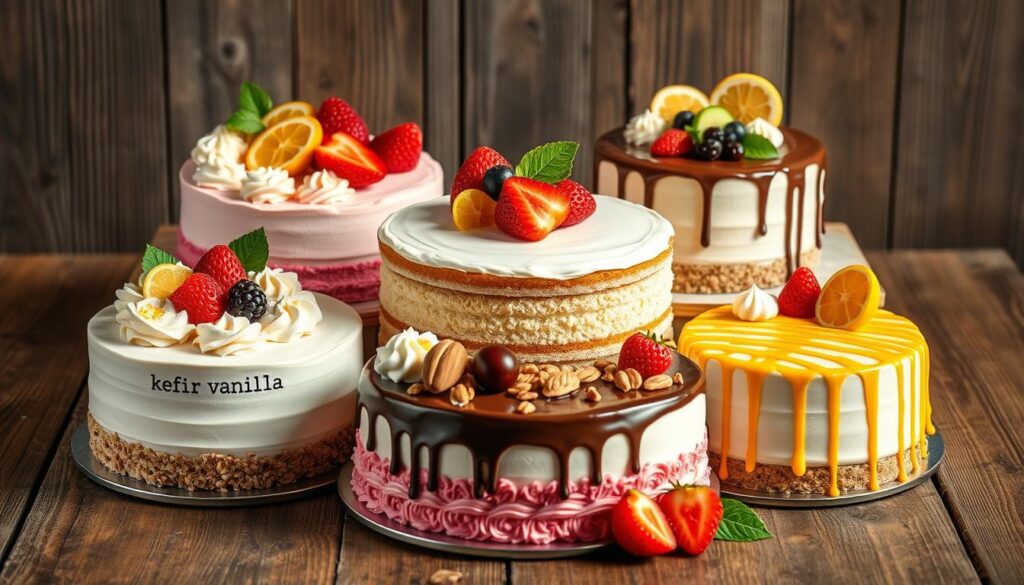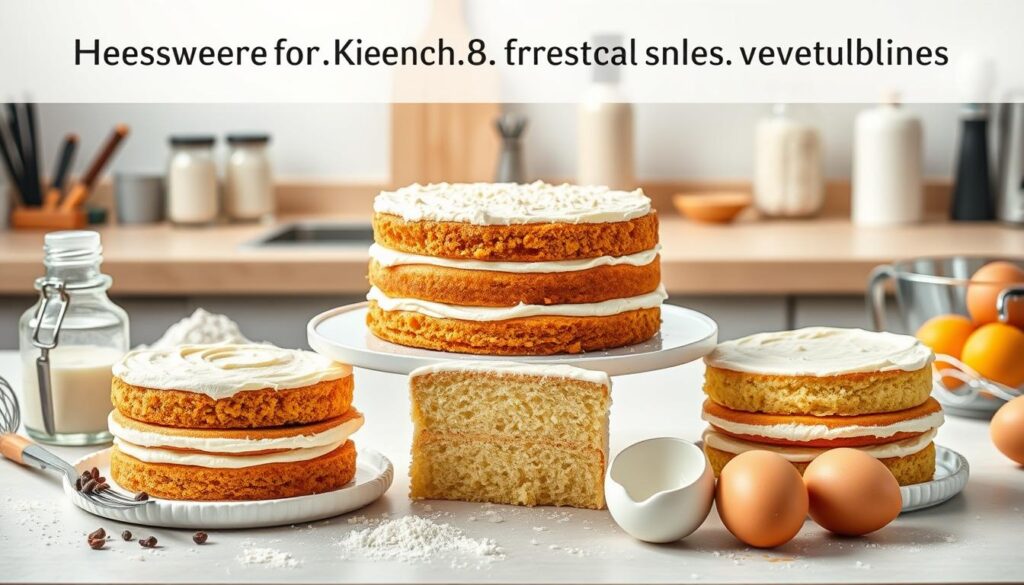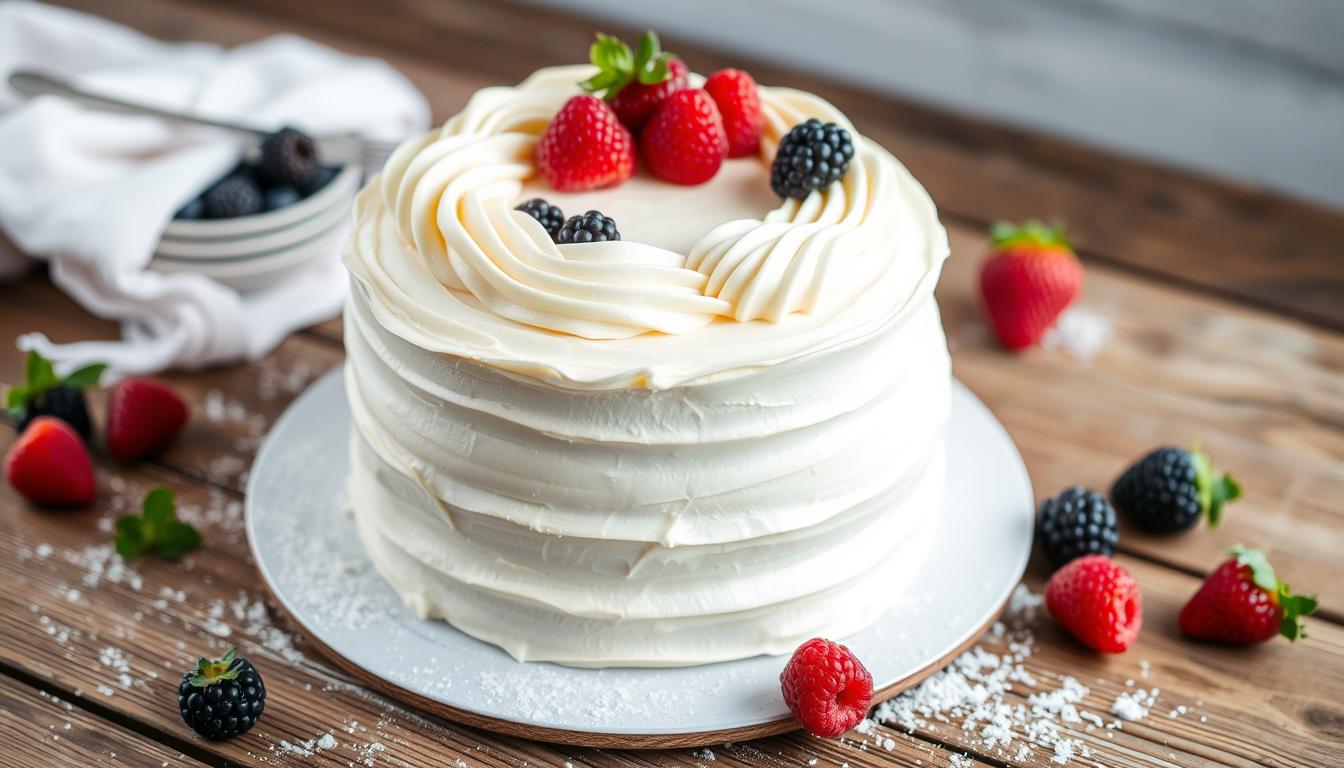Every home baker knows the magic of creating a dessert that makes any day special. My journey with the classic kefir vanilla cake started as a simple experiment. It became a family favorite probiotic dessert that we enjoy at every gathering.
This cultured milk cake is more than just a recipe. It’s a delightful twist on traditional baking. It combines the tanginess of kefir with the rich, creamy vanilla flavor everyone loves. Imagine a cake so light and moist that it practically melts in your mouth—that’s the promise of this incredible kefir-based creation.
You’ll unlock the secret to a bakery-quality dessert with just three simple steps. It’s both delicious and surprisingly easy to make. No professional baking skills required – just a willingness to try something wonderfully different.
Key Takeaways
- Discover the unique texture of a kefir-based vanilla cake
- Learn a foolproof method for creating a moist, fluffy dessert
- Explore the probiotic benefits of baking with kefir
- Create a versatile cake that works for any occasion
- Master a simple recipe that impresses every time
Understanding Kefir’s Magic in Baking
Baking turns simple ingredients into amazing treats. Kefir, a fermented recipe, adds a special touch. It makes cakes not only delicious but also good for your gut.
What Makes Kefir a Perfect Baking Ingredient
Kefir is more than just a dairy product. It changes baking in big ways. It adds moisture, tanginess, and probiotics, and makes baked goods light and fluffy.
- Adds incredible moisture to baked goods
- Introduces natural tanginess
- Provides probiotic benefits
- Helps create lighter, fluffier textures
The Science Behind Kefir’s Leavening Properties
Kefir and baking powder together create magic. The acidity in kefir works with baking powder to make air bubbles. This makes your cake light and tender.
“Kefir transforms ordinary baking into an art of flavor and nutrition” – Baking Enthuasiasts Magazine
Health Benefits of Baking with Kefir
Your cake is now a health boost. Kefir adds probiotics that are good for your gut. Each slice has beneficial bacteria that regular baking can’t offer.
| Nutrient | Benefit |
|---|---|
| Probiotics | Supports digestive health |
| Calcium | Strengthens bones |
| Protein | Builds muscle tissue |
Choosing kefir means you’re baking more than just a cake. You’re making a tasty, healthy treat that’s good for your body and taste buds.
Essential Ingredients for Your Kefir Cake
Creating a tasty kefir cake begins with selecting the proper ingredients. Your cake will be a guilt-free treat with top-notch components. Let’s look at the key ingredients for a tasty and healthy cake.
Key Ingredients Breakdown
- Kefir: The star ingredient that provides moisture and a subtle tangy flavor
- All-purpose flour: Creates a soft, sturdy cake structure
- Granulated sugar: Balances the kefir’s tanginess with sweetness
- Fresh eggs: Bind ingredients and contribute to perfect texture
- Baking powder or baking soda: Helps the cake rise beautifully
- Pure vanilla extract: Enhances overall flavor profile
- Salt: Brings out the cake’s subtle taste nuances
Each ingredient is important for a balanced cake. Kefir makes the cake moist and light. This recipe is healthier and tastier than traditional ones.
“Baking is about precision, but also about passion. The right ingredients make all the difference.” – Pastry Chef Wisdom
Ingredient Quality Matters
Choose fresh, high-quality ingredients for the best kefir cake. Use room-temperature eggs, full-fat kefir, and pure vanilla extract. High-quality ingredients greatly impact both the flavor and texture.
| Ingredient | Recommended Type | Quality Impact |
|---|---|---|
| Kefir | Full-fat, plain | Maximum moisture and tang |
| Flour | All-purpose, unbleached | Better structure and texture |
| Vanilla Extract | Pure, not imitation | Rich, authentic flavor |
Your kefir cake will show the importance of good ingredients. Enjoy making a delicious, healthy dessert that’s good for you and tastes great.
Classic Kefir Vanilla Cake: Base Recipe
Making a classic kefir vanilla cake needs care and focus. This recipe turns simple baking into a special treat. Knowing how to prepare and mix ingredients is key to getting that creamy vanilla taste right every time.
Room Temperature Ingredients Matter
Good baking starts with the right ingredients. Allowing the ingredients to reach room temperature is essential. Cold ingredients can mess up mixing and change the cake’s feel.
- Remove eggs and kefir from refrigerator 30-45 minutes before baking
- Ensure butter is soft but not melted
- Let ingredients sit at room temperature to blend smoothly
Mixing Technique Tips
Right mixing makes your ingredients into a tasty cake. Don’t overmix, or your cake might be tough and dense.
- Combine dry ingredients separately
- Whisk wet ingredients in another bowl
- Gently fold ingredients together until just combined
- Stop mixing when no flour streaks remain
Baking Temperature Guidelines
Getting the baking temperature right is key. It makes your cake golden outside and soft inside.
| Ingredient | Quantity |
|---|---|
| All-purpose flour | 2 cups |
| Kefir | 1 cup |
| Sugar | 1 cup |
| Eggs | 2 large |
| Vanilla extract | 1 tsp |
“Baking is a science, and precision is key to creating the perfect cake.” – Professional Baker
Heat your oven to 350°F (180°C). Bake for 35-40 minutes. Check with a toothpick. The cake is done when the toothpick is clean and the top is golden.
The Perfect Texture: Tips and Tricks
Making the perfect kefir cake is more than just a recipe. It’s about finding the right texture for a guilt-free treat.
To get that light and fluffy texture, you need to be precise. Here are some tips to make your kefir cake stand out:
- Ingredient Temperature Matters
- Always use room-temperature ingredients
- Let eggs and kefir sit out for 30 minutes before mixing
- Mixing Techniques
- Mix the batter just until the ingredients combine
- Avoid overmixing to keep the cake light
- Baking Secrets
- Preheat the oven to the exact temperature
- Use an oven thermometer for accuracy
- Minimize opening the oven door to maintain consistent baking conditions
“The magic of tangy probiotic goodness lies in the details of preparation.”
These steps are key to a moist and tender kefir cake. With patience and focus, your baking will go from good to great.
Common Mistakes to Avoid
Making the perfect cultured milk cake needs care and detail. Even skilled bakers face issues with this nourishing vanilla dessert. Knowing the common problems helps you make a delicious treat every time.
Overmixing: The Silent Cake Killer
Overmixing can ruin your cake’s texture. It makes the cake dense and tough. Here’s how to avoid it:
- Mix ingredients just until they are combined
- Stop stirring when no dry streaks remain
- Use a gentle folding technique
Temperature Control Challenges
Getting the right temperature is key for a perfect cake. Wrong oven temperatures can cause uneven baking and bad results.
| Temperature Issue | Potential Outcome | Solution |
|---|---|---|
| Oven Too Hot | Burnt exterior, raw center | Use an oven thermometer |
| Oven Too Cool | Flat, dense cake | Preheat thoroughly |
Storage Mistakes to Prevent
Proper storage helps maintain your cake’s freshness and flavor. Wrong storage can dry out your cake or mess up its texture.
“A well-stored cake is a delicious cake!” – Baking Experts
- Always cool completely before storing
- Use an airtight container
- Refrigerate for extended freshness
- Consume within 3-4 days
Avoiding these mistakes will help you make a stunning probiotic dessert that wows everyone.
Flavor Variations and Add-ins
Your classic kefir vanilla cake doesn’t have to be boring! Try exciting flavor changes to make your kefir cake a culinary masterpiece. This cake is versatile, letting you mix in different ingredients for a surprise.

- Chocolate Twist: Add 1 tablespoon of unsweetened cocoa powder to dry ingredients
- Fruity Variations:
- Fresh berries (strawberries, blueberries)
- Diced apples
- Sliced bananas
- Citrus Enhancements: Incorporate lemon zest and juice
- Spice Options: Warm spices like cinnamon, nutmeg, or ginger
Each mix adds a special touch to your kefir vanilla cake. The trick is to add ingredients carefully to keep the cake light.
| Flavor Variation | Key Ingredients to Add | Recommended Quantity |
|---|---|---|
| Chocolate | Unsweetened Cocoa Powder | 1-2 tablespoons |
| Berry Burst | Fresh or Frozen Berries | 1 cup, gently folded |
| Spiced Delight | Ground Cinnamon | 1-2 teaspoons |
| Nutty Crunch | Chopped Nuts | 1/2 cup |
“Baking is an art, and your kefir cake is the canvas!” – Pastry Chef Recommendation
Be gentle when adding mix-ins to avoid overmixing. Your creativity can turn a simple cake into a show-stopper that shows off your style.
Frosting and Topping Options
Turn your nourishing vanilla dessert into a stunning centerpiece with these tasty frosting and topping ideas. A beautifully decorated kefir cake can make your guilt-free treat truly special.
Classic Vanilla Buttercream
The perfect frosting for your kefir cake is easy to make. You’ll need:
- 3 sticks (1½ cups) softened butter
- Powdered sugar
- Vanilla extract
- A pinch of salt
Beat these ingredients until they’re smooth and not too sweet. This buttercream will enhance the tangy taste of your kefir cake.
Fresh Fruit Decorations
Make your cake pop with fresh fruit. Berries are a great choice. They add color and a flavor that matches your cake.
- Strawberries
- Raspberries
- Blueberries
- Sliced peaches
Cream Cheese Frosting Alternative
For a tangier topping, try cream cheese frosting. It pairs well with the soft kefir cake and adds a creamy touch.
“A great frosting can transform a simple cake into a memorable dessert experience.”
Expert tip: Experiment with various toppings to discover your favorite. Whether it’s classic buttercream or a fruit-topped cake, your kefir cake will impress everyone.
Storage and Shelf Life
Making a delicious cultured milk cake is just the start. Knowing how to store it ensures you can enjoy it for days. This keeps its amazing flavor and texture intact.
Your freshly baked kefir sheet cake needs careful storage. This keeps its moisture and taste just right. Storing it at room temperature is perfect for short-term enjoyment. It stays fresh and tasty for up to two days.
Storage Guidelines
- Cool the cake completely before storing
- Use an airtight container to prevent moisture loss
- Keep at room temperature for 2-3 days
- Refrigerate for extended freshness for up to one week
Freezing Your Cake
Freezing is a great way to keep your probiotic dessert fresh for longer. It’s important to wrap it properly to keep its quality.
| Storage Method | Duration | Recommended Technique |
|---|---|---|
| Room Temperature | 2-3 days | Store in an airtight container |
| Refrigeration | Up to 1 week | Wrap securely with plastic wrap |
| Freezer | 2-3 months | Double wrap in plastic wrap and foil |
“Properly storing your cultured milk cake turns it from a simple treat into a lasting culinary masterpiece.” – Baking Experts
When you’re ready to enjoy your frozen cake, thaw it slowly. You can defrost it by leaving it in the refrigerator overnight or letting it sit at room temperature for a few hours. For individual slices, a quick 10-15 second microwave warm-up will make it feel fresh again.
Pro tip: Always let your cake cool completely before storing. This prevents condensation, which can make it soggy.
Troubleshooting Guide

Baking the perfect classic kefir vanilla cake can sometimes present challenges. This troubleshooting guide will help you navigate common baking issues. It ensures your nourishing vanilla dessert turns out delightful every time.
Common Cake Challenges
- Dry Cake Texture: If your cake lacks moisture, check these possible causes:
- Verify oven temperature accuracy
- Reduce baking time by 2-3 minutes
- Add an extra splash of tangy probiotic goodness (kefir) to the batter
- Sinking Cake Center: Prevent mid-cake collapse by:
- Avoiding opening the oven door during baking
- Ensuring proper leavening agent quantities
- Checking ingredient freshness
Baking success depends on precision and understanding your ingredients. The kefir in your cake acts as a natural tenderizer. It creates a uniquely moist texture when used correctly.
Diagnostic Baking Troubleshooting
| Problem | Potential Cause | Solution |
|---|---|---|
| Uneven Baking | Incorrect oven temperature | Use an oven thermometer for accuracy |
| Cake Sticking | Inadequate pan preparation | Grease and flour pan thoroughly |
| Bland Flavor | Ingredient quality | Use fresh vanilla extract and high-quality kefir |
“Baking is about precision, patience, and passion.” – Unknown Pastry Chef
Remember, each baking challenge is an opportunity to refine your skills. Create an even more delicious classic kefir vanilla cake. Practice makes perfect!
Serving Suggestions and Pairings
Your kefir cake deserves the perfect match to enhance its creamy vanilla taste. The right pairing can turn a simple dessert into a memorable treat. Here are some ways to serve and enjoy your guilt-free delight.
Beverage Companions
Choosing the right drink can make your kefir cake even better. Try these exciting pairings:
- Hot beverages: Freshly brewed espresso or chai tea
- Cold drinks: Iced tea or sparkling lemonade
- Seasonal options: Warm apple cider in fall, refreshing mint tea in summer
Seasonal Serving Ideas
Your kefir cake can change with the seasons:
| Season | Serving Suggestion |
|---|---|
| Spring | Top with fresh strawberries and edible flowers |
| Summer | Serve with a scoop of homemade berry sorbet |
| Fall | Dust with cinnamon and serve with spiced pear compote |
| Winter | Pair with warm vanilla custard sauce |
Special Occasion Presentations
Make your kefir cake a standout dessert for special events:
- Elegant garnishes: Chocolate shavings, edible gold leaf
- Plating techniques: Drizzle with caramel sauce
- Accompaniments: Serve with a small scoop of vanilla bean ice cream
“A great dessert is about creating moments of pure joy and connection.” – Pastry Chef Sarah Thompson
With these ideas, your kefir cake will be a hit at any gathering. The secret is to try new things and find the perfect match for this versatile dessert.
Kefir Substitutes in Emergency
Don’t worry if you’re out of kefir for your recipe. There are great alternatives to keep your cultured milk cake tasty and probiotic.
Here are your top picks for emergency substitutes:
- Buttermilk: It’s the closest match with a tangy flavor and acidity
- Plain yogurt: Mix it with milk to get a kefir-like texture
- Non-dairy options: Try almond or coconut milk with a squeeze of lemon juice
“Baking is about adaptation – when one ingredient is missing, creativity saves the day!”
Think about nutrition when picking substitutes. Different options change the texture and protein:
- Regular yogurt has 170 calories and 6g protein
- Greek yogurt has 175 calories and 9g protein
- Plant-based yogurts might need more flour
Pro tip: Use the same amount of substitute as kefir. Your cake might taste a bit different, but it will be yummy!
Choose a substitute based on your diet and what you need. Dairy substitutes are best for keeping the cake’s texture and taste.
Conclusion
Your classic kefir vanilla cake is more than a dessert. It’s a guilt-free treat that changes traditional baking. By using kefir, you’ve made a healthier version of sheet cakes. Each slice is a mix of rich taste and health benefits, perfect for those who love tasty yet healthy snacks.
This cake is very flexible, letting you try many different flavors. You can keep it simple with vanilla or add fresh fruits, chocolate chips, or unique frostings. Its moist texture and light crumb make it always delicious, impressing everyone at gatherings.
Learning this recipe opens up new possibilities in baking. You’ve picked up important skills, from choosing ingredients to mixing techniques. Your kefir vanilla cake shows that healthy food can be super fun, making every dessert moment special.
Baking is both an art and a science. With time, effort, and love, you’ll get better and make unforgettable treats. Enjoy the process of baking and relish every bite of your homemade cake.
FAQ
What is kefir and why is it used in baking?
Can I substitute kefir with another ingredient?
How long is it safe to keep a kefir sheet cake stored?
What are some common mistakes to avoid when making a kefir cake?
Can I add different flavors to my kefir cake?
Is kefir cake healthy?
What are the best frostings or toppings for a kefir cake?
Can I make a kefir cake gluten-free or dairy-free?
What did you think of our recipe?
There are no reviews yet. Be the first one to write one.

